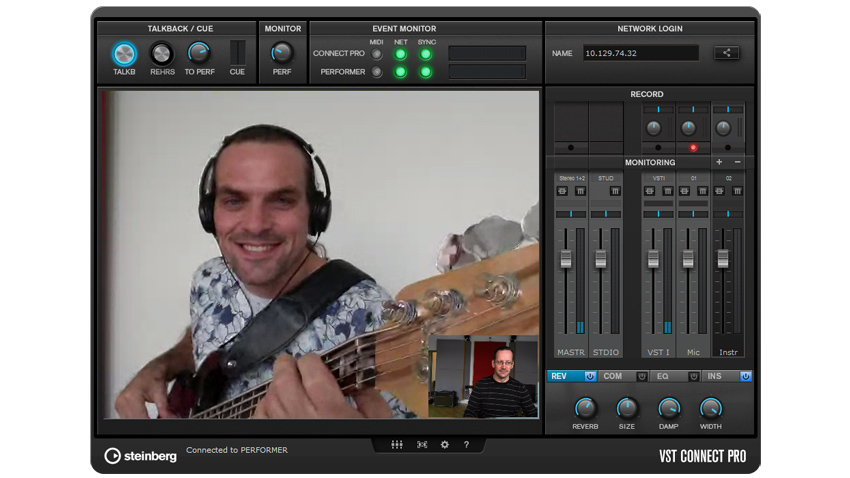12 tips for musicians who want to work remotely and collaborate online
Being confined to the studio is no reason not to create with other people

With social distancing currently on everyone's agenda, you may be wondering if it's still possible to make music with other people.
Fortunately, technology means that the conventional boundaries of distance no longer apply. So, why not take advantage these advances to write and produce music with people anywhere in the world?
To successfully collaborate online, there are a number of things you need to consider. Here are 12 pointers to help you on your way...

• Best website builders for musicians 2019: get your music heard
1. Don't keep quiet
Working with lots of people on a project can be really interesting, as it allows for a potentially much larger range of influences and ideas. But there is also a danger that you can lose your way. If you feel like the project has lost direction, speak up and let the group know.
Make sure you do this in a friendly way, with concrete examples to back you up - having a SoundCloud reference of how the project sounded at an earlier point will help!
2. Use remote storage
High-quality stereo audio files can be a hassle to send back and forth over the net due to their large size. If you change one part, you could just resend that bit, but it gets confusing fast as the recipient loses track of what's going on.
Avoid all this hassle by using a service such as Dropbox to keep projects in sync across multiple machines and users. The default free allowance is usually enough for one project.
Get the MusicRadar Newsletter
Want all the hottest music and gear news, reviews, deals, features and more, direct to your inbox? Sign up here.
3. Bounce wet and dry
When bouncing a channel with huge amounts of reverb or delay, it's usually worth bouncing a version without those heavy effects as well. These kinds of things can be very subjective, and it's easy for somebody to get frustrated with a part and start to dislike it if they can't adjust it or even hear a dry version.
4. Watch the levels
When bouncing channels, be careful not to overdrive either the master output or the input levels into any plugins, as this can result in digital clipping and a different response from the plugins respectively.
5. Give it a chance
If somebody suggests a change to something you're used to hearing, it can be extremely difficult to view the new version as anything but inferior.
To banish this problem, try living with the change they've suggested for a day or so, working on the track with it in. We're not saying that they're always going to be right, but sometimes you need to let things bed in before you can be objective about them.
6. Specify a format
Always check what format somebody wants their files in before you send them. Some DAWs offer 32-bit export, but others don't allow 32-bit files to be imported, for example. A problem as simple and easily avoided as this can utterly derail a planned studio session.
7. Cut out silences
If you're working with lots of bounced tracks, you might find your hard drive buckling under the pressure. First, consider upgrading to much faster solid-state storage. If this is a no-go, try slicing any significant gaps out of each audio file in the arrangement. That way your hard drive won't be accessing every bounce simultaneously for the whole track.
8. Specify software versions
When collaborating with somebody using the same DAW, make sure that you're working with the same version. Some DAWs aren't backward-compatible, so this could mean that the person running the older version won't be able to open files saved in the newer one. It's easy to overlook this issue, so make sure you ask ahead of time.
9. Save out samples
Watch out for plugins that reference sample banks, as even if you tell your sequencer to save a project and all of its assets, they might not be included. To get round this, save your sampled patch out and share this with your partner, too.
10. Check for licences
A lot of soundbanks are copy-protected these days, including some sample libraries. Make sure you check that your partners have the required licences - if not, it's time to bounce again.
11. Be flexible
Don't be afraid to work in different DAWs and just swap bounced parts. Some people work best using multiple platforms (moving, say, from Live to Logic), so let each producer play to their (and their DAW's) strengths. If you hear something that you'd like to edit, make a note and let your partner know.
12. Break it up
If you and your partner find yourself constantly disagreeing over what sounds best, things seem forced and difficult, you never finish any projects, or things just clearly aren't working, then don't waste your valuable music-making time continuing the partnership.
Collaboration should be fun, rewarding and productive; you should bring the best out of each other. If this isn't happening, find somebody else to work with.
Computer Music magazine is the world’s best selling publication dedicated solely to making great music with your Mac or PC computer. Each issue it brings its lucky readers the best in cutting-edge tutorials, need-to-know, expert software reviews and even all the tools you actually need to make great music today, courtesy of our legendary CM Plugin Suite.
“From a music production perspective, I really like a lot of what Equinox is capable of – it’s a shame it's priced for the post-production market”: iZotope Equinox review
"This is the amp that defined what electric guitar sounds like": Universal Audio releases its UAFX Woodrow '55 pedal as a plugin, putting an "American classic" in your DAW










